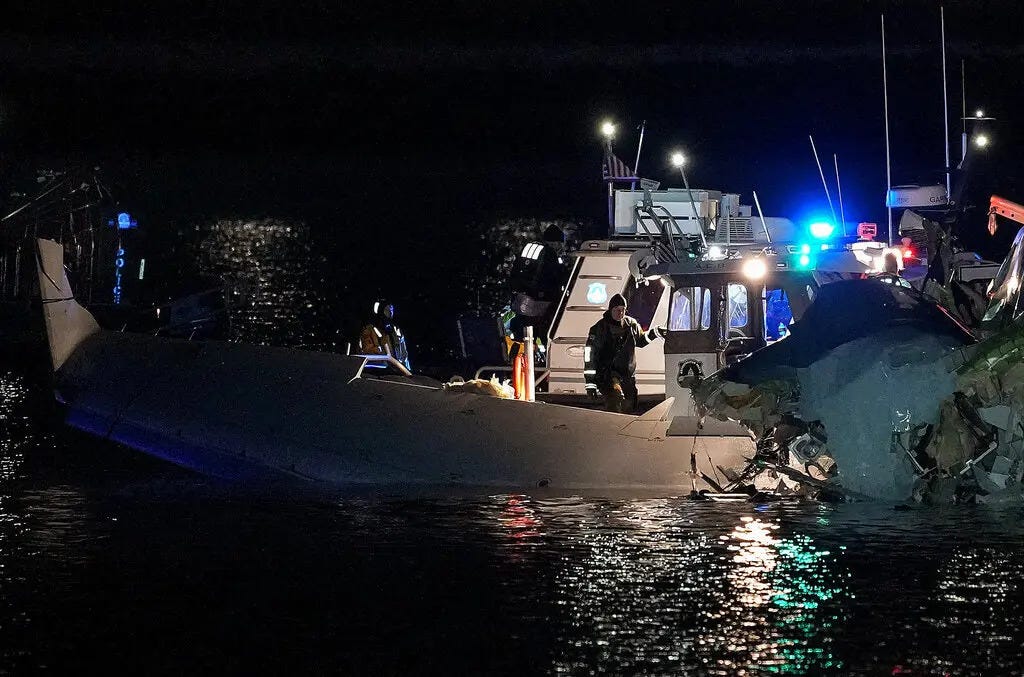Why the Reagan crash is a labor issue
or, Fuck Ronald Reagan
Around 9:00 p.m. on Wednesday, January 29, 2025, American Eagle Flight 5342 collided with a Black Hawk military helicopter while approaching Runway 33 at Ronald Reagan Washington National Airport, five miles outside of DC. The crash occurred above the Potomac River that separates Virginia from the capitol. Rescue operations began almost immediately and involved 300 first responders, including divers. Efforts were complicated by the cold, wind, and murky water. As of Thursday morning, officials believe there to be no survivors among the 60 passengers and 4 crew members aboard AA 5342. Over two dozen bodies have been found, and the search has now pivoted to recovery.
We are still learning the details about what led to this catastrophe, and there will likely be thousands of hours devoted to learning the truth—or at least as close to it as we can come. We do know, however, that the crash appears to be most serious air disaster involving a commercial jet in the US since 2009, when Colgan Air Flight 3407 fell onto a house at 6038 Long Street in Clarence Center, New York. We also know that neither aircraft lost communication with the traffic controllers on the ground who are responsible for ensuring flight safety through airspace oversight. And finally, we know that US aviation has been experiencing a critical shortage of air traffic controllers for now many years.
Air traffic control is grueling, and the roots of the present crisis stretch back to 1981, when the Professional Air Traffic Controllers Organization (PATCO) declared a strike demanding higher wages, better benefits, and—notably—a 32-hour work week. Controllers have significantly higher stress levels than the general population, and their performance can deteriorate rapidly when “on position” over two hours without breaks, even at low traffic levels. After a two-day standoff (and despite supporting PATCO during his campaign the previous year), then President Ronald Reagan summarily fired 11,345 striking controllers who ignored a federal order to end to the strike.
The effects of Regan’s decision were devastating for both the aviation industry and organized labor. The training process for new controllers took three years under normal conditions, and airports were forced to rely on an army of strikebreakers, including supervisors, military controllers, non-rated personnel, and other staff. By firing so many controllers at once, Reagan disrupted the very “free market” dynamics he supposedly supported, creating a situation wherein large numbers of controllers are hired and retire at once, rather than a gradual inflow of new trainees and outflow of seasoned veterans, the comingling of which are a crucial element of many professions.
The falloff of demand during COVID-19 produced a wave of early retirements and hiring freezes. In 2024, the Federal Aviation Administration recorded 1,115 runway incursions between May and November. According to Avonics International, 46 close calls involving commercial aircraft occurred in August 2023 alone. In December 2023, Reuters reported that many facilities have instituted six-day weeks and mandatory overtime, the opposite of the changes PATCO sought in 1981. Even when the controller shortage isn’t a matter of life and death, it can cause substantial delays; 800 in two weeks when a mere 24 controllers were transferred from Newark to Philadelphia in July 2024.
Given the conditions under which controllers work, it’s a small miracle that the US has gone a full 15 years without a major commercial aircraft crash. And of course, controllers cannot in and of themselves ensure the safety of perhaps the world’s most complex and high stakes transportation system. On January 25, 2024, two pilots of an Indonesian airline fell asleep with more than 150 passengers on board. A few weeks earlier on January 5, 2024, a door plug blowout forced an emergency landing of Alaska Airlines Flight 1282 at Portland International Airport. One fact is abundantly clear: the working conditions of those who provide our safety directly impacts the safety they’re able to provide.



